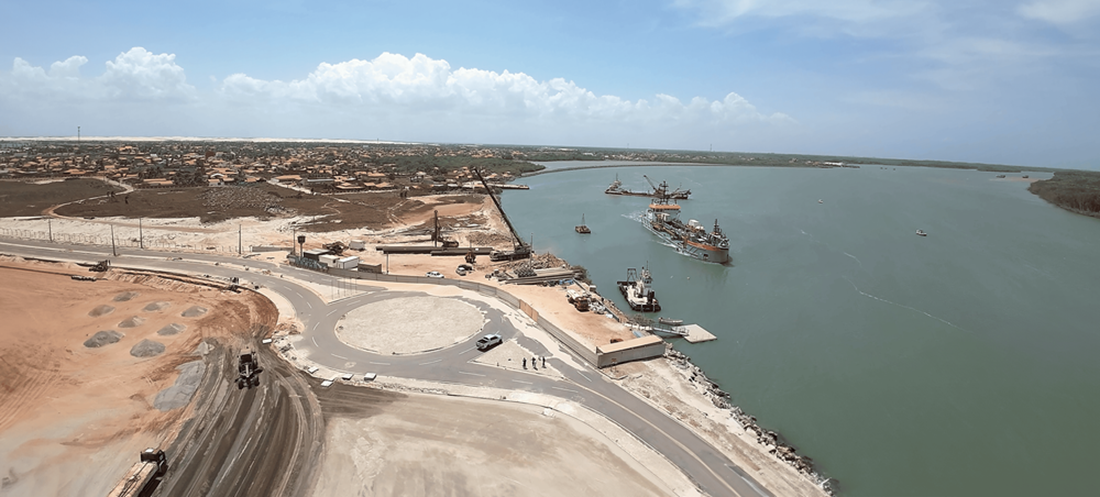
Luis Correia Port Inaugurated After 50-Year Wait, Aims to Double Piauí’s GDP
Dec, 15, 2023 Posted by Gabriel MalheirosWeek 202345
More than 50 years after its conception, the state of Piauí gained its first port in Luís Correia on Wednesday (13), on the state’s coast. According to the Secretariat of the Environment, the port is expected to double Piauí’s Gross Domestic Product (GDP) within the next ten years.
The construction of the port will also play a crucial role in investments in the state’s green hydrogen (H2V) production. Piauí has entered into an agreement with the European Union involving over R$60 billion, which will be invested in Green Hydrogen production.
“Here, we will have the grain terminal and also the Green Hydrogen and clean energy terminal, so this terminal will also be used to export the green hydrogen produced in the Export Processing Zone,” said Secretary Daniel Oliveira.
To mark the beginning of the first step, the port welcomed three ships from the Brazilian Navy, receiving authorization for operation from the Ministry of Ports and Airports and the National Waterway Transportation Agency (Antaq).
In practice, this document serves as a kind of “birth certificate” for the port, which, over the years, has been the subject of much controversy and debate in the state.
History and Significance
The construction has been highly anticipated for economic reasons. According to the government, the state loses approximately R$300 million in revenue each year because products destined for the state have to arrive via the Ports of Itaqui in São Luís (MA) and Porto do Pecém in Ceará.
The initial hydraulic and hydrological studies for the port date back to the late 1960s. However, construction only began between the 1970s and 1980s, being halted in 1986 due to insufficient funds.
In 1988, the port’s operation was granted to the Government of the State of Piauí for 50 years, and in 1991, the construction and operation of the port were sub-conceded to the company Inace. However, the company did not invest in the project for about 16 years, leading to the termination of the sub-concession contract.
Controversies
In 2009, funds were injected into the SEP budget for the project’s second stage, and a commitment agreement for approximately R$14 million was signed with Setrans/PI.
The amount was subject to tender in 2010, and a contract was signed with the Consortium Staff/Paulo Brígido for around R$14.3 million. The Consortium Staff/Paulo Brígido received payments totaling R$11,553,525.7 for executing the two stages. However, irregularities were identified, such as flaws in project development, discrepancies between the object of the work plan and the bid, and indications of overpricing.
In 2022, the Federal Court sentenced former managers, employees, and entrepreneurs for embezzling over R$5.4 million in federal funds earmarked for the port’s construction.
Resumption of Works
Construction works restarted on March 2023 after years of being halted. Investments were made in the wharf, dredging, and urbanization of the area.
For the 3.5-kilometer dredging, R$64,197,087.86 was allocated, removing over 600,000 cubic meters of sand from the water bottom, increasing the draft to nine meters in the Igaraçu River.
The wharf, with an investment of R$33,153,865.45, is nearing completion, according to the state government, with a structure measuring 180 meters in length by 35 meters in width.
Urbanizing the inland area, the external area that houses essential logistical and customs activities for the port’s operation costs R$13,746,248.74. The construction includes creating streets, an access gate (port access portal), and an administrative center.
Port Operation
The port is capable of receiving vessels with a length of 60 meters, a draft of 6 meters, and a beam of 11 meters.
However, regular ship operations, transporting goods back and forth, will only be possible after installing specific terminals built by companies interested in operating at the site.
The state government estimates that goods will be transported through the port in the second half of 2024 once the first terminal is completed.
Initially, there are expected to be four terminals at the port, reflecting Piauí’s current economic focus: a fishery terminal, a grains and fertilizers terminal, a general cargo loading and unloading terminal, and a green hydrogen and ammonia terminal.
These terminals will be operated by companies under concession. The government predicts that constructing the four terminals will cost R$1 billion, with most funds coming from private companies.
The government stated that a company that mines iron ore in Piripiri and another that wants to transport lithothamnium, a type of marine limestone, are interested in participating in the project.
According to the government, a public call for companies interested in operating the port and managing the terminals is expected to be made by February 2024.
However, the fishery terminal is being built by Investe Piauí, a mixed economy company created by State Law No. 7,495/2021, to encourage the installation of industries at the location. Therefore, this will be the first terminal to operate, as its construction is underway. It will also involve private companies being contacted by the state government.
-
Grains
Jun, 22, 2020
0
Thailand’s inclusion of two agribusiness chemicals as harmful sparks protests from Brazil and USA
-
Ports and Terminals
Aug, 01, 2023
0
Trucks are targets of theft and the robbing of grain before arriving at the port of Paranaguá
-
DW 2019 EN
May, 27, 2019
0
DatamarWeek 28 May 2019
-
Economy
May, 31, 2020
0
IBGE data shows agribusiness is only sector to show growth in first quarter


